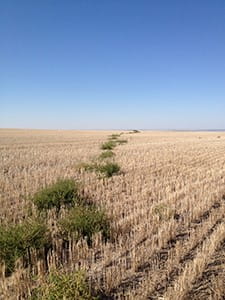In Saskatchewan there are currently 16 weed species that have been confirmed to be resistant to herbicides. Four are grassy weeds and 12 are broadleaf weeds. The herbicide groups that have one or more weeds resistant to them are Groups 1, 2, 3, 4, 9, 14, 15 and 25.
Plants can be herbicide resistant or herbicide tolerant.
Herbicide resistance is the ability of a plant to survive and reproduce after exposure to a rate of herbicide that would normally kill it. One redroot pigweed plant or a redroot pigweed patch surviving an application of a Group 2 herbicide when all the other redroot pigweed plants are controlled is an example of possible herbicide resistance.
Herbicide tolerance is the natural ability of a type or species of plants to survive and reproduce after an herbicide application. Broadleaf plants not being affected by Group 1 herbicides is an example of herbicide tolerance.
Weeds can also survive if there was a sprayer miss in a field. A sprayer miss will have sharp defined edges, straight boundaries, parallel lines that are the width of the sprayer or between nozzles if there is a nozzle or nozzles that were not working properly and multiple weed species will survive in the missed area.
Herbicide resistant weed patches will not have sharp lines and the boundaries are less defined. A general pattern that follows where the combine was in the past or where seeds were spread by a water run are two examples of possible herbicide resistant weed populations. For tumbleweeds like kochia, seeds will fall as the dry plant rolls in the wind. If the plant dropping seeds was herbicide resistant, there can be a line across the field of plants that survive herbicide application in the future. If you suspect that some weeds of one species are resistant, herbicide injury causing death should be present on other plants of the same species nearby in the field.
If you suspect that you have herbicide resistant weeds, the Crop Protection Lab can test weed seeds that are properly sampled, packaged and handled. Please note that processing times vary and results cannot be guaranteed by seeding the following year.
Sample requirements:
- A minimum of 2,000 seeds per herbicide subgroup. If you want multiple herbicide groups or more than one Group 1 subgroup tested, you need to have 2,000 seeds per subgroup.
- Mature, healthy seed from the suspect plants that have survived the herbicide application (green or diseased seed will not germinate properly and will slow down the diagnosis or make it not possible).
- Do not submit seed that has been treated with a pre-harvest herbicide.
- Do not submit stems in the sample.
- As little foreign material as possible.
Packaging and handling:
- Seeds must be dry before shipping. Seeds that arrive mouldy or become mouldy during processing will not be tested. To dry seeds, allow them to air dry for a few weeks on paper. Place them in a paper bag to ship them to the lab.
- All samples should be sent with a fully completed Herbicide Resistance Testing Request Form.
More information about herbicide resistance can be found in the front of the 2023 Guide to Crop Protection.
To hear Glenda-Lee's conversation with Shannon Chant click on the link below.
